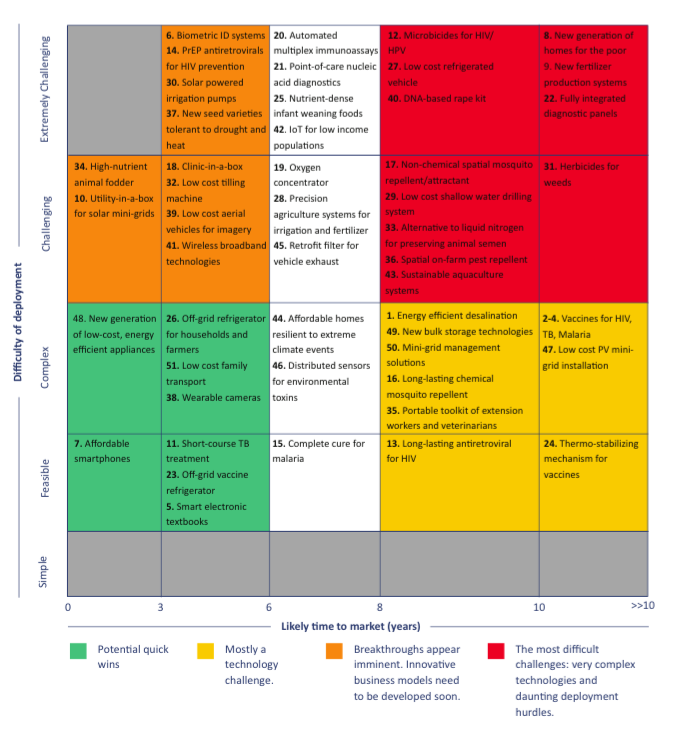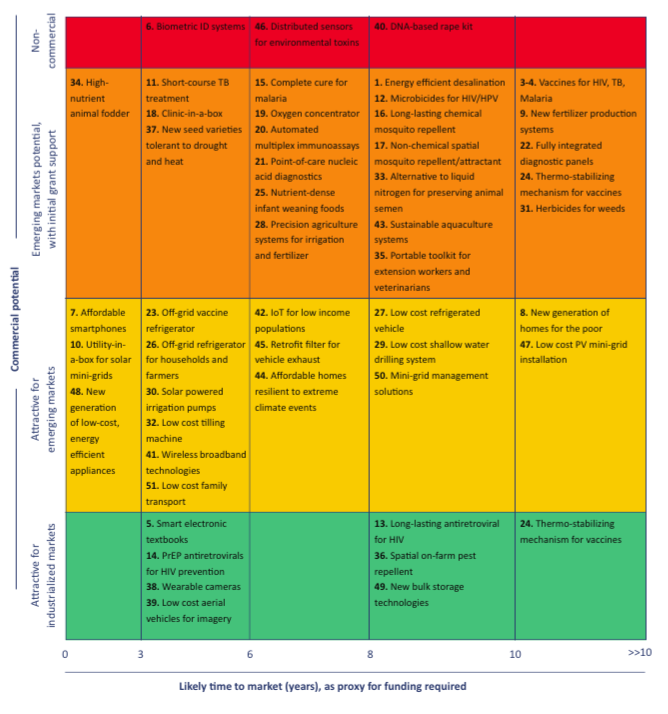Simple technologies like Kenya’s M-Pesa mobile money system can have a huge impact in the developing world. Offering something genuinely new, reliable and, above all, cheap, they can stitch together communities, catalyze markets, improve economies, and ultimately change lives.
So here’s the question: What other technologies could have a similar impact?
The Institute for Globally Transformative Technologies (LIGTT) at the Lawrence Berkeley National Lab has been thinking about that and recently published 50 Breakthroughs: Critical scientific and technological advances needed for sustainable global development. The study looks at innovations (actually there are 51) that don’t exist yet, but could be feasible through work by scientists, engineers, and designers, and with support from philanthropies, aid agencies, businesses, and others.
“They represent breakthroughs because they have to be dramatically different from existing technologies in industrialized settings: available at a fraction of the cost, requiring only a fraction of the energy, significantly less reliant on technical skills to operate, not needing elaborate infrastructure, and being generally robust and maintenance-free,” says the report.
From our partners:
The ideas cover health, food security and agricultural development, human rights, education, digital inclusion, water, access to electricity, gender equality, and climate change, with the focus on the lives of the poor in South Asia and sub-Saharan Africa.
Here are some of the ideas. The report charts the technical complexity of achieving each innovation with estimated years to completion and the commercial potential for each idea. LIGTT hopes funders will be inspired to follow up, placing dollars and manpower where they can have maximum impact.
HEALTH
Health makes up the biggest category in the report, with 16 ideas. They include obvious, and highly important things, like new HIV/AIDS, malaria and tuberculosis vaccines (these diseases kill almost four million people a year), and less obvious things like a low-cost (sub-$10,000) solar-powered birthing kit for mothers. Other items on the wish-list: condom substitutes (because men don’t like wearing them), integrated diagnostic systems for rural clinics, and longer-lasting antiretroviral therapies (because today’s HIV drug cocktails are expensive and too toxic).

FOOD AND AGRICULTURE
This is the second largest category, with 12 ideas. These include new types of fertilizers that are less harmful for the environment and allow farmers to use fewer inputs to achieve the same yields; cheap fridges, so farmers don’t waste so much food after harvesting; and new ways of freezing animal semen (because using liquid nitrogen is too expensive). LIGTT also wants to see kits that would be useful to extension agents and other agricultural support workers, including diagnostics for animal diseases, a vaccine cooler, tests for soil and water quality, and seeds that are more tolerant to drought, heat, and other environmental stresses. Meanwhile, a sub-$50 tilling machine would allow farmers to remove weeds without using so many herbicides.
HUMAN RIGHTS
Technology could really help enforce human rights in developing countries and improve transparency. For example, cheap biometric identification systems could be crucial for registering births and land rights, enabling financial and medical services, and holding governments accountable. Cheap wearable cameras and aerial drones can record violations that were previously undocumented.
WATER
We’re entering an era of increasing water scarcity. The wish-list calls for a sub-$100 water drilling machine, solar powered pumps for less than $50, and desalination technologies that are less energy-intensive than those available today.

ELECTRICITY
Renewable energy provides opportunities for unconnected communities to leapfrog grid-based architecture and move directly to the future. The report calls for a utility-in-a-box (“a bundled package of mini-grid components that can be easily integrated and installed”), cheaper solar mini-grids, low-power household appliances, energy storage (so more energy captured by solar and wind can be used), and tools to manage mini-grids.
DIGITAL INCLUSION
To be full-fledged global citizens, the poorest need better access to digital technology, including iPhone-equivalent phones in the sub-$50 range and broadband delivered by low-altitude satellites and aerial devices.
CLIMATE CHANGE AND THE ENVIRONMENT
Another big category. LIGTT wants to see homes that are more resilient to extreme weather, cheap filters that can be retrofitted to vehicle tailpipes, and “robust, reliable, and affordable monitoring technologies” to measure toxins and the health threats they pose.
Some of these ideas are new, and others are already being pursued. Either way, it’s a want list with big ambition. Read the full report here.
This feature is adapted from Fast CoExist



















